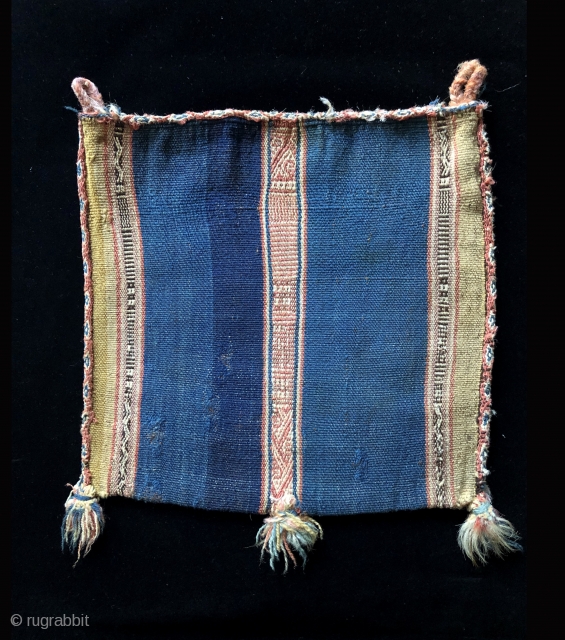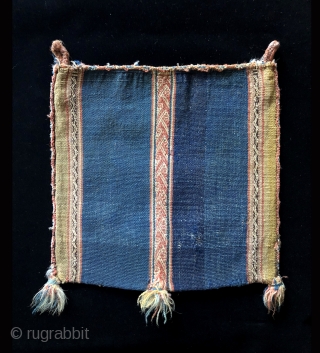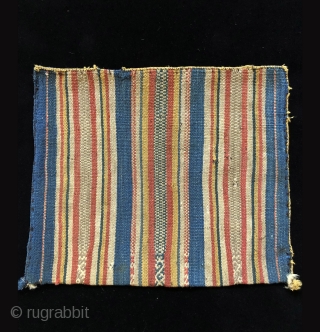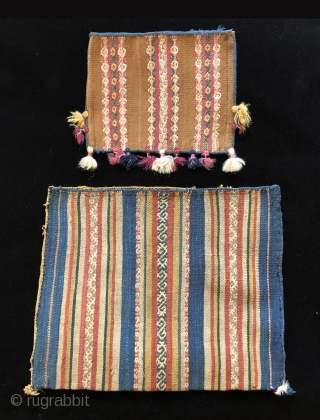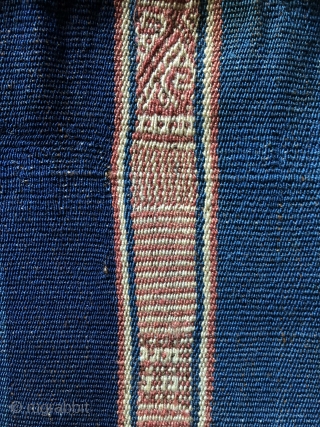These two alforjas with rarely seen indigo blue grounds are something special. They are both early and remarkable in there own ways. To illustrate the size differential between Aymara coca bags meant to hold coca leaves and alforjas meant to hold the bundles of medicinal herbs, healing potions and other implements of Kallawaya healers. The name Kallawaya translates to "Lords of the Medicine Bag" See the image in this post with a mid-sized coca bag and a typical, larger Alforja for scale. The coca bag design layout, like that of the alforja has three complimentary warp woven pattern bands against a plain ground. This is one of primary design arrangements found on woven coca bags from the South Central Andes since ancient times. It is also found on alforjas with some frequency. The tan ground coca bag has a field that is woven from yarns spun from the super fine hair of a vicuna – a small, wild camelid and cousin to the domesticated alpaca . Alpaca fiber is the primary source for most ceremonial Aymara weavings. Because the vicuna was never domesticated - its fibers are very hard to come by and the distinctive camel color and remarkably fine, soft fiber of the vicuna is treasured and valuable throughout the Andes. Because of this vicuna yarns are never dyed. They are used as is because the very color and softness denotes wealth and prestige. During Incan times it was said to be reserved for the use of the Inca himself and his retainers. It is known to be one of the finest animal fibers in the world.
As stated before in the previous tutorial the reverse sides of alforjas are patterned differently than the front sides of these bags. On the reverse side or face of an alforja (side b) the complimentary warp patterned design technique is discontinued and a simple plain weave pattern results which can take on the look of horizontal bars or “zipper-like” patterns. For me personally, the simple backs of some alforjas are often more endearing than the fronts. On both of these blue ground alforjas the design is continued somewhat onto the back face of the bag. Though not so rare as to be amazing this is unusual. The bag with the yellow edges has an especially active pattern variation. More unusual, however is the beautiful indigo blue ground of both bags. Indigo dyed yarns are usually used only in moderation in Aymara and other andean weavings because indigo was difficult and expensive to obtain. Because of this it was primarily reserved for important weavings. Among andean weavers, the Aymara use indigo with far more frequency than other weavers. In earlier times the indigo trade was controlled by The Tiwanaku Culture - the most important Andean culture during the Middle Horizon period (a.d.500 - a.d. 1000) of Andean history. The Aymara made up the very important pastoralist segment of the Tiwanaku population at that time and were active traders with large caravans of llamas transporting goods through the South Central Andean region.
- Home
- Antique Rugs by Region
- Category
- Profiles
- Post Items Free
- Albums
- Benaki Museum of Islamic Art
- Budapest: Ottoman Carpets
- Gulbenkian Museum
- Islamic Carpets. Brooklyn
- Islamic Textiles. Brooklyn
- Konya Museum: Rugs
- MKG, Hamburg
- MMA: Caucasian Carpets
- MMA: Mamluk Carpets
- MMA: Mughal Indian Carpets
- MMA: Ottoman Carpets
- MMA: Safavid Persian Carpets
- MMA: Turkmen Rugs
- McCoy Jones Kilims
- Ottoman textiles. Met
- Philadelphia Museum
- Rugs and Carpets: Berlin
- Seljuqs at the Met
- TIEM, Istanbul: Carpets
- V&A: Classical Carpets
- Vakiflar Carpets: Istanbul
- Baluch Rugs: Indianapolis
- Gallery Exhibitions
- Jaf an Exhibition
- Alberto Levi Gallery
- Andean Textile
- Christie's London: 2016
- Francesca Galloway
- HALI at 40
- ICOC Washington, DC 2018
- Jajims of the Shahsavan
- London Islamic Week April, 2018
- Mongolian Felts
- Navajo Rugs: JB Moore
- Persian Piled Weavings
- SF Tribal & Textile Art Show 2020
- SF Tribal 2019
- Sotheby's: C. Alexander
- Turkish Prayer Rugs
- Turkmen Main Carpets ICOC 2007










